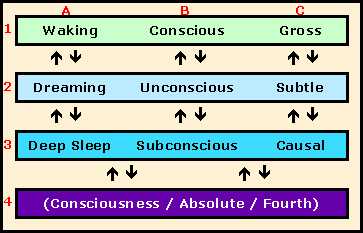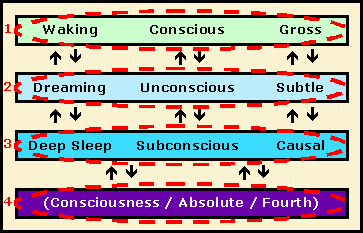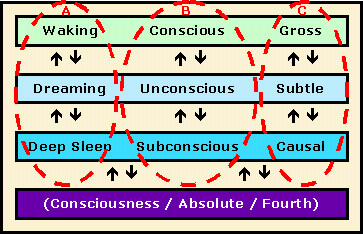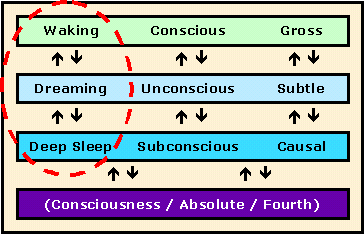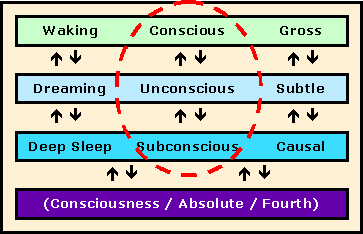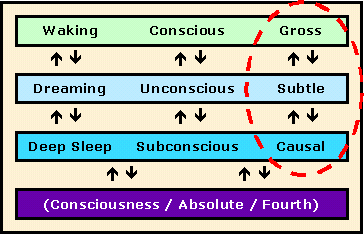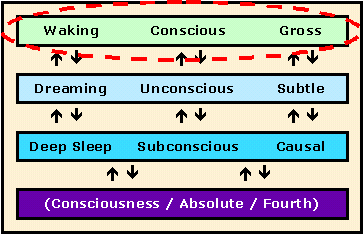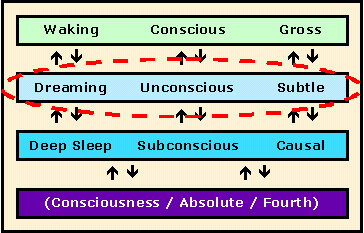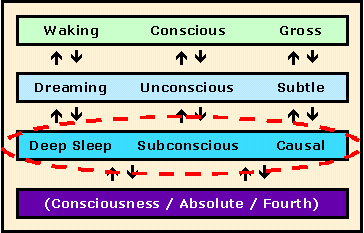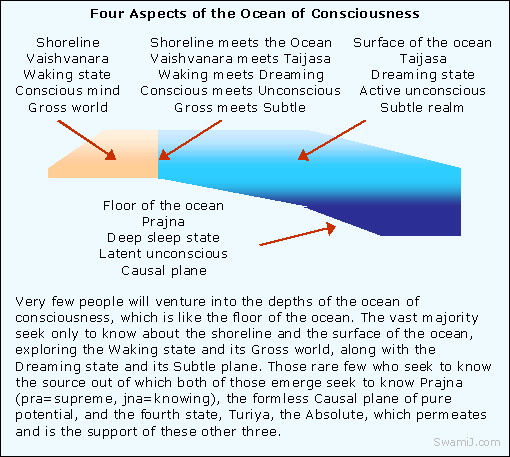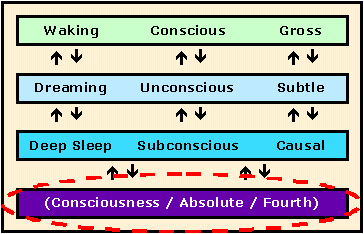|
Home Site Map CDs OM 7 levels 7 OM practices Mahavakyas Koshas |
||||
|
|
Four levels and three domains: Reality expresses or manifests itself in:
Audio Podcast:
Contents of this web page:
Practical principles: These are practical principles used daily in Contemplation and Yoga Meditation, not merely abstract principles (4 Practices). For a dedicated seeker of Self-Realization who wishes to tread the Advanced path of Yoga, Vedanta, and Tantra, these principles and associated practices of self-exploration and self-awareness are crucial. 4 Levels of Consciousness
3 Domains of Consciousness
3 States of Consciousness
Three states of consciousness: Every day, we move through three states of consciousness: 1) Waking, 2) Dreaming, and 3) Deep Sleep. Like a river: These three states of consciousness can be thought of as being like the parts of a river:
Waking: In the Waking state of consciousness, we utilize the Conscious mind, and experience the Gross realm of existence. The Unconscious and Subconscious minds are being used, though out of conscious view. The Subtle and Causal realms are still there, underneath the Gross realm, though these too are normally out of view to one in the Waking state. Dreaming: In the Dreaming state, consciousness recedes from the Waking state. The Conscious mind recedes back into the subtler levels, and we lose awareness of the Gross world. The Subconscious mind is still being accessed, as latent impressions arise into the Dreaming state. In the Dreaming state, one may also have access to the Subtle realm, just as one in the Waking state has access to the Gross realm. Through Yoga Meditation, one also may have access to the Subtle realm, though the seeker of Self-Realization will learn to let go of such experiences, as they are a diversion, and are not the True Self. Deep Sleep: In the Deep Sleep state, consciousness recedes from both the Waking state and the Dreaming state, and we lose awareness of both the activity of the Gross realm and the activity of the Subtle realm. The Conscious mind and the Unconscious processing part of mind also recede back into the latent bed of the Subconscious from which they emerged in the first place. Through deep Yoga Meditation or Yoga Nidra (yogic sleep), one may experience the Deep Sleep state while fully conscious. In this state there are no objects, no pictures, no images or impressions. All of those are visible in the Subtle and Gross, while at this level they remain in their latent, dormant, or merely potential formless form. In Yoga Meditation:
In Yoga Nidra (yogic sleep):
3 States of Mind
Three states of mind: We function with three states of mind: 1) Conscious, 2) Unconscious, and 3) Subconscious. These can also be thought of as a river, being like the surface of the river, the flowing undercurrent of the river, and the latent bed of the river that gives shape to both the flowing undercurrent and the surface. Conscious: The Conscious mind is the part we experience in our active lives. However, the Unconscious and Subconscious are also actively being utilized in service of the Conscious mind, with all three levels working together as an integrated whole. Unconscious: The Unconscious mind is processing at the same time, much like the microchip in a computer processes outside of our conscious view. Normally we only experience the Unconscious Mind during Dreaming sleep, when the many images and impressions combine and re-combine to form inner realities. Subconscious: The Subconscious repository of data, memories, and recorded impressions is also there, much like the hard disk drive of a computer. It is drawn upon as needed for the Unconscious and Conscious. Impressions arise from this bed of Subconscious, causing a stirring of the Unconscious and Conscious emotions and thoughts, as well as leading to actions and speech in the external world. When we see objects or people in the Dreaming state, it is from the Subconscious that the mind draws the memory of those images. During Meditation:
3 States of Manifestation
Three states of manifestation: Consciousness expresses in three states of manifestation: 1) Gross, 2) Subtle, and 3) Causal. The interaction of these three lead to the emergence of what we know as our external world. These three are also like a river, the surface of a river, the flowing undercurrent of the river, and the latent bed of the river that gives shape to both the flowing undercurrent and the surface. Gross: The Gross realm is the domain of the five elements of earth, water, fire, air, and space in their gross form (bhutas). These five gross elements are the building blocks out of which particles (protons, neutrons, and electrons), atoms, molecules, compounds, and objects emerge. The Gross realm emerges out of the Subtle realm. Subtle: The Subtle realm is the domain of the five elements of earth, water, fire, air, and space in their etheric or subtle aspect (tattvas). These five subtle building blocks transition into the five gross elements of earth, water, fire, air, and space (bhutas), which are operating in the Gross realm. The Subtle realm emerges out of the Causal realm. Causal: The Causal realm is the domain of pure potential, the ground of being, the unmanifest foundation. It can be likened to the canvas on which a painting will be painted. The Causal plane includes the most basic of building blocks, called Gunas, of which there are three. The three Gunas are: 1) Sattvas (lightness), 2) Rajas (activity), and 3) Tamas (heaviness). These three combine and re-combine so as to form the five subtle elements of the Subtle realm. The Causal derives from pure Consciousness itself. Level of Waking / Conscious / Gross
Three aspects of the first level: There are three aspects of the first, or most external level of reality: 1) the Waking state of consciousness, 2) the Conscious state of mind, and 3) the Gross realm of manifestation. These three are all are operating at the same level of reality or existence. The Waking state of consciousness: The waking state is the most external of the three states of consciousness. It is the state where the Conscious mind is active, and in which awareness is often most directed towards either one's own Conscious thought process, or towards the external or Gross world. The Conscious aspect of mind: The conscious mind is the most external of the three states of mind. It is the dominant aspect here, where one is also in the Waking state, and where one is most often aware of the objects that are in the Gross world. The Unconscious and Subconscious are usually operating invisibly, behind the scenes. The Gross realm of manifestation: The gross realm is the most external of the three stages of manifestation. Its objects are usually the focus of attention for the Conscious mind, that is used in the Waking state of consciousness. While the Subtle and Causal realms are existent in the same moment, these are usually not seen at this level of mind and consciousness. This first level is symbolized by "A": In the AUM Mantra this Waking level of consciousness is symbolized by the "A" sound of "AUM". Level of Dreaming / Unconscious / Subtle
Three aspects of the second level: There are three aspects of the second level of reality: 1) the Dreaming state of consciousness, 2) the Unconscious state of mind, and 3) the Subtle realm of manifestation. These three are all operating at the same level of reality or existence. The Dreaming state of consciousness: The second of the three states of consciousness is the state where the Unconscious mind is most active. The Conscious mind has receded, and awareness is directed toward the seemingly endless stream of images and impressions of the Unconscious or the Subtle realm. The conscious control of attention available in the Waking state is less available here, where attention is easily drawn into the streams of images and impressions flowing in the Unconscious field of mind, or coming from the Subtle realm. The Unconscious aspect of mind: The second of the three states of mind is the Dreaming state, where one is aware of objects from the internal stream of thought patterns or the images and objects of the Subtle world. The Conscious aspect of mind has receded, while the Subconscious is providing a constant flow of impressions to feed into the Dream process. The Subtle realm of manifestation: The second of the three stages of manifestation is the Subtle realm. Its endless stream of alluring or fearful objects is the focus of attention for the Unconscious mind, used in the Dreaming state. While awareness of the Gross world has receded, the Causal is still existent, silently underneath the Subtle. This second level is symbolized by "U": In the AUM Mantra this Dreaming level of consciousness is symbolized by the "U" sound of "AUM". Level of Deep Sleep / Subconscious / Causal
Three aspects of the third level: There are three aspects of the third level of reality: 1) the Deep Sleep state of consciousness, 2) the Subconscious state of mind, and 3) the Causal realm. These three are all operating at the same level of reality or existence. The Deep Sleep state of consciousness: The deepest of the three states of consciousness is the state where the Subconscious mind is encountered, and in which awareness has no gross or subtle objects on which to focus, but instead can focus on the formless forms of the potential, latent, inactive thought patterns, as they rest in the bed of the mind-field. The Subconscious aspect of mind: The deepest of the three states of mind is the dominant aspect here in this Deep Sleep state, where one is aware of the latency of personal thought patterns. One who becomes aware of this level through the process of Yoga Nidra (Yogic sleep), begins to have access to thought patterns in their latent form. Through Yoga Nidra, one can weaken these latent habit patterns called samskaras, and can effectively reduce the effects on karma (the actions that would play out as a result of the samskaras). The Causal realm of manifestation: The deepest of the three stages of manifestation and its pure potential, in unmanifest form, is the focus of attention for the mind in Deep Sleep. If one who is in Deep Sleep were alert to this Causal level, there would be an increasing access to what has been called the infinite library of wisdom, as this Causal plane is the place from which the creativity of the Subtle and the Gross emerges. This third level is symbolized by "M": In the AUM Mantra this level of consciousness is symbolized by the "M" sound of "AUM".
Level of Consciousness / Absolute / Fourth
The indivisible level: This level is indivisible, and in sense, cannot even be called a level. This One reality of Consciousness equally permeates and supports the three levels or realms that emerge out of this One. It is called Turiya which is literally the Fourth state of Consciousness. Consciousness itself: Consciousness itself is the characteristic of this level. It is not really separate from being the "Absolute" reality at the same time. "Consciousness," "Absolute," and the "Fourth" are really one and the same. Unchanging, eternal, and indescribable: The Absolute reality is not subject to death, decay, or decomposition. It is unchanging, was never born, and never dies. It cannot be divided or subdivided. It has no causal support from which it is derived. The Absolute reality has been often called indescribable, but, for convenience sake, has been call Sat-Chit-Ananda, which is Existence-Consciousness-Bliss. The fourth contains the three: The Fourth is the literal meaning of the word Turiya, which is the state beyond the other three (though it also permeates those three). To know this Fourth state is to know Truth, Reality, Self. This is the Source that gives support to, and actually is the three States of Consciousness, the three States of Mind, and the three States of Manifestation. This fourth level is symbolized by silence: In the AUM Mantra this fourth level is symbolized by the Silence after the "A" "U" and "M" sounds of "AUM". Consciousness flows equally: At this level there is One, pure Consciousness that flows equally throughout all, though it may appear to be individuated.
Domain of the Self: This Fourth state, Turiya, is the domain of the Self, the eternal aspect of our being. The direct experience of Turiya is Self-Realization.
------- This site is devoted
to presenting the ancient Self-Realization path of the Tradition of
the Himalayan masters in simple, understandable and beneficial ways,
while not compromising quality or depth. The goal of our sadhana or
practices is the highest Joy that comes from the Realization in
direct experience of the center of consciousness, the Self, the
Atman or Purusha, which is one and the same with the Absolute
Reality. This Self-Realization comes through Yoga meditation of the
Yoga Sutras, the contemplative insight of Advaita Vedanta, and the
intense devotion of Samaya Sri Vidya Tantra, the three of which
complement one another like fingers on a hand. We employ the
classical approaches of Raja, Jnana, Karma, and Bhakti Yoga, as well
as Hatha, Kriya, Kundalini, Laya, Mantra, Nada, Siddha, and Tantra
Yoga. Meditation, contemplation, mantra and prayer finally converge
into a unified force directed towards the final stage, piercing the
pearl of wisdom called bindu, leading to the Absolute.
|
|
||
